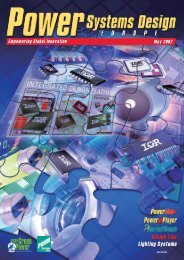Powering Freight & Transportation - Power Systems Design
Powering Freight & Transportation - Power Systems Design
Powering Freight & Transportation - Power Systems Design
You also want an ePaper? Increase the reach of your titles
YUMPU automatically turns print PDFs into web optimized ePapers that Google loves.
Avoiding Current Spikes<br />
The relationship between voltage<br />
and current is similar to the relationship<br />
between water pressure<br />
and water flow. Higher water pressure<br />
represents higher voltage and higher<br />
water flow represents higher current.<br />
One can observe flow or pressure, both<br />
or neither, depending on the system<br />
under consideration. For example, when<br />
compared to a standard garden hose,<br />
a fire hose has high pressure and high<br />
flow. Contrast this to the Amazon River<br />
which has a much higher flow and lower<br />
pressure. An example of high pressure<br />
and no flow is the water behind a dam.<br />
The dam acts like an open switch in an<br />
electronic circuit storing water (voltage)<br />
for immediate release.<br />
To fully understand the difference<br />
between incandescent bulbs and<br />
semiconductors such as LEDs, let us<br />
consider voltage driven devices for a<br />
minute. The filament of an incandescent<br />
bulb is simply a resistor. When electrically<br />
powered, the filament heats to near<br />
white hot temperature - more than<br />
5,800°F or 3,250°C. The high temperature<br />
of the filament generates the light.<br />
When first powered, the filament is cold<br />
and has a much lower resistance than<br />
when it is hot. According to<br />
Ohm’s law, V = I R, the current in the<br />
filament is higher when the bulb is first<br />
turned and the filament is cold. This cur-<br />
www.powersystemsdesign.com<br />
with LEDs<br />
rent is known as the “in-rush” current.<br />
Very quickly after turn-on, the filament<br />
heats to its operating temperature. As<br />
the filament heats, the resistance goes<br />
up dramatically and the current drops<br />
proportionately. In much less than a<br />
second, the filament resistance stabilizes<br />
and the current is constant.<br />
Due to the characteristics of filaments,<br />
driver designs for bulbs expect<br />
an in-rush current as part of their<br />
performance. As long as the voltage is<br />
constant, bulbs tolerate these current<br />
fluctuations. However, bulbs are very<br />
sensitive to voltage variations. Different<br />
sources cite different levels of sensitivity,<br />
a recent check of Wikipedia stated<br />
the lifetime of a bulb was dependant on<br />
the inverse of the sixteenth power of the<br />
voltage. In other words, an increase in<br />
voltage of only 5% could have a dramatic<br />
effect on the lifetime of the bulb.<br />
Using the equation:<br />
Lifetime bulb = (105% V rated / 100% V rated) -16<br />
(representing a 5% increase in Voltage)<br />
Lighting<br />
Hot switching can destroy any LED.<br />
Well designed drivers are the simple solution<br />
Unlike many illumination sources, such as incandescent bulbs that are voltage driven, LEDs are current<br />
driven devices. This distinction requires different considerations when designing and using driver<br />
electronics. Here, we compare incandescent bulbs to LEDs to highlight this subtle difference.<br />
By Pat Goodman, Technical Director, Philips Lumileds, San Jose, California<br />
Figure 1: Typical switched circuit.<br />
Lifetime bulb = (1.05) -16<br />
Lifetime bulb = 45.8% of initial lifetime<br />
Simply stated, a 5% increase in voltage<br />
decreases the bulb lifetime by more<br />
than half. Therefore, for a robust product<br />
performance, incandescent bulbs depend<br />
on well-regulated voltages while<br />
being tolerant to some current fluctuations.<br />
LEDs are current-sensitive devices.<br />
However, although slight changes in<br />
current, such as the 5% mentioned<br />
above, do not affect LEDs nearly as<br />
much as similar changes in voltage affect<br />
filaments in bulbs, it is still important<br />
that designers consider transient<br />
peak currents when implementing LED<br />
driver circuits. Specifically, there are a<br />
few areas where switching on the LED<br />
causes current spikes that exceed the<br />
circuit design current by many times.<br />
Fortunately, “forewarned is fore-armed”<br />
as they say, and some simple considerations<br />
eliminate occurrences of these<br />
current spikes.<br />
41









